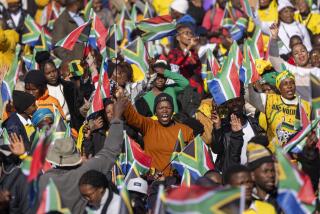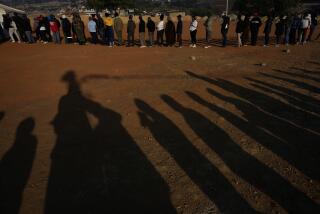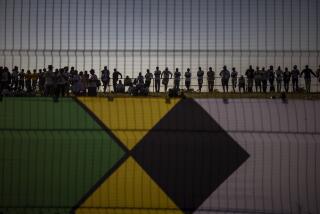New shine on City of Gold
Johannesburg, South Africa — I was sitting at a restaurant when the Canadian woman across the table from me said something that caught me off-guard.
“I love this city.”
At first I thought she was getting carried away by the ambience. We were dining at Sides, a chic establishment whose modern minimalist interior was highlighted with African art, and we had eaten shark carpaccio, hearty bowls of fettuccine with mushrooms and a sinful sticky-toffee pudding with a warm crust. It was all very wonderful indeed, but wasn’t she taking things a bit far? This city was, after all, Johannesburg.
She went even further.
“This city is so exciting, so exuberant, so beautiful,” she said, “I could move here.” She was on her second visit in six months, her first having been to attend the 2002 Earth Summit. The weeklong event, as it happened, had been a watershed for Johannesburg, not only because of its magnitude and slick execution but also because it introduced more than 70,000 foreigners to a city they may never have visited otherwise. And many of them, like the Canadian woman, were enchanted.
“The only thing I couldn’t understand,” she said, echoing a sentiment I heard repeated often, “was why I hadn’t thought of coming here before.”
There may not be another city in the world so large — close to 4 million in the 2001 census — so vibrant and so culturally rich that is so far off travelers’ radar screens. Johannesburg has top-class restaurants and galleries; a theater world where at the same time last year you could see Michael Flatley’s “Lord of the Dance,” an African version of “Julius Caesar” and the ballet “Coppelia.” It also has excellent shopping, trout-fishing within half an hour’s drive of downtown and a 2-billion-year-old fossil site that has provided paleontologists with 40% of the evidence that points to human evolution.
A scar on the city’s image
Yet most visitors to South Africa barely stop over for longer than it takes to change planes for some other destination, usually Cape Town or a safari. If Johannesburg weren’t the country’s major hub, visitors would probably skip it altogether.Why? Crime.
I’m tempted at this point to identify several other popular international destinations that also have high crime rates, but I won’t. Those places are more famous for something else — and that usually includes a waterfront. Johannesburg is one of the world’s few major cities not built on water. It is 30 miles from the nearest large river, the Vaal, and 300 from the Indian Ocean, and although its most acclaimed asset, gold, lies unseen, its extraction has left behind numerous unattractive mine dumps.
When a wave of homicides and carjackings hit the city in the mid-1990s, its image got worse.
In the last few years, though, crime has been falling, zero tolerance has become a catch phrase and city officials liken Johannesburg’s cleanup to New York’s in the ‘80s and ‘90s. The U.S. State Department nevertheless warns that South Africa, and Johannesburg in particular, has “significant street crime such as muggings, pickpocketing and random street violence.”
Pretoria is the capital, but Johannesburg is the commercial hub of the country, often regarded as New York to Cape Town’s San Francisco. It displays the nation’s best and worst, the plushest mansions created by its wealth and the poorest shanties created by a legacy of political and economic inequality. It has become a magnet for immigrants looking for new opportunities, and the mix of good and bad, local and international, has led to an apt saying: If you haven’t seen Johannesburg, you haven’t seen South Africa.
Each time I visited the city annually after 2000, I noticed refreshing changes. People were still taking precautions, locking their car doors wherever they drove, avoiding parts of town like Hillbrow and the City Center, and keeping their valuables close at hand. But there were more profound shifts, that, as a onetime Joburger, I kept noticing.
Entire suburbs where residents had emigrated to Australia were being gussied up by their new owners. People were walking their dogs again. Cafés were moving their tables onto the sidewalks. And most everyone was upbeat — a combination of the better security, the clement weather (Johannesburg, situated on a high plateau, has plenty) and a booming economy.
A good place to see this vibrant energy is Melrose Arch, a new precinct of shops, restaurants, offices and lofts not far from downtown. I was walking around Melrose Arch one night — jazz music spilling out of the Kilimanjaro nightclub, restaurant tables overflowing onto the central piazza and people sipping coffee at outdoor cafés — when I momentarily forgot where I was. The high-tech architecture, tiled murals and rows of palm trees reminded me of a city in southern Europe or North America.
Many people, in fact, confuse Johannesburg with Los Angeles. If it’s not the culture of driving everywhere, it’s the glut of convertibles, the ribbons of highways, the gated suburban neighborhoods, the spectacular houses, the glitzy malls of Sandton and Rosebank, and the beautiful people forever talking on cellphones. One of its nicknames, City of Gold, calls to mind the City of Angels.
But Johannesburg has other, more popular names, among them Joburg, Jozi and the Sotho translation for City of Gold, Egoli. Whenever you think you’re in a glossy city, Egoli pops up to bring you back to Africa. In the shadow of the 50-story Carlton Center, for instance, the taxi-jammed square is named after Mahatma Gandhi, who, while working here as a lawyer in the early 1900s, formulated his philosophy of passive resistance, satyagraha.
At almost every traffic light, the latest model BMW or Aston Martin jostles for attention with traders selling a diverse lot of goods, from fruit to garden furniture. At the popular Sunday flea market in Rosebank, a white grandmother peddles homemade sweaters in a stall next to a Congolese woman selling mudcloth from Mali. And cheek-by-jowl with the rich, spacious suburbs of the north is the politically charged, overcrowded township of Alexandra.
Not far from Alex, as it’s popularly called, is a casino named Caesars. I don’t usually go to casinos when I travel, but Johannesburg has acquired several over the last few years and they are impressive — and difficult to ignore. Before 1994, when Nelson Mandela was elected president, South Africa’s casinos were hidden away in the homelands created by apartheid. Since then, gambling venues have sprung up all over the country, although nowhere do they seem more appropriate than in Johannesburg, where countless fortunes were made and lost.
When gold was discovered here in 1886, it triggered the biggest gold rush ever and attracted fortune hunters from all over the world. The shantytown grew so fast and chaotically — with the population rocketing to 100,000 in a decade — that little time or attention was paid to making something beautiful out of it.
Few people, so the story goes, expected the city to last longer than the gold. But it did, and that’s when the landscapers got busy. Trees were planted with almost fanatical abandon, and even the suburb names tried to make up for the recreational space that was lacking: thus, Parktown, Parkview, Parkhurst and Parkmore. And today, the city is so verdant it has been called the most treed city in the world; it is possibly also the most birded. Even the unsightly mine dumps have been prettified, and if plants wouldn’t grow in their cyanide-rich soil they were used for something else, such as an elevated drive-in or a snowless training slope for skiers.
I passed on the mine dumps, choosing instead to take in a view of Johannesburg’s green-mantled ridges from the Westcliff hotel, a cluster of villas owned by the Orient-Express company. From where I ate breakfast, near the pool, a carpet of trees stretched away below me that was so dense, it was hard to imagine that only a few hundred yards away was the Johannesburg Zoo, while all around the hotel were mansions built at the turn of the last century by men who got rich off gold.
Little remains of Johannesburg’s original mining town, although a facsimile has been created at Gold Reef City. There you can wander through 19th century streets and even take a trip down a mineshaft, although most people go to play at the casino or enjoy theme park rides.
The best reason I found to visit Gold Reef City, however, had nothing to do with Johannesburg’s days as a mining town but with its role as a center of politics. The new Apartheid Museum, an oddity given its casino-theme park surroundings, recalls how much of the struggle against apartheid took place here. Gandhi lived here and so did Winnie Mandela for much of the time her husband was imprisoned. In its streets, women wore black sashes every Friday to protest apartheid. Nelson Mandela was arrested in Rivonia, now a fancy northern suburb.
The Soweto uprisings of 1976 focused world attention on racial injustice and Hector Pietersen — in whose name a new Soweto museum has been created — was the first child in those protests to be fatally shot by police.
Solemn and richly evocative, the Apartheid Museum helps you understand Johannesburg and South Africa. Its exterior is made of stark concrete, and its walls are covered in wire, like a prison, while inside, segregationist signs, videos and exhibits take you through almost a century of racism and the protests that ended with the country’s liberation. Some people see it as tacky, having a theme park and a casino right across from a museum that has such an important message. Yet to me, those two extremes sum up the harsh beauty of this addictive city just perfectly.
*
(BEGIN TEXT OF INFOBOX)
*
Jewels of Johannesburg
GETTING THERE:
From LAX, connecting service to Johannesburg is available on American or Delta to New York’s JFK International Airport, connecting to South African, Lufthansa, British, Virgin Atlantic, Air France or Swiss airlines. Restricted round-trip fares begin at $1,794 until Dec. 7 and from Jan. 7 to March 31; fares begin at $2,214 from Dec. 7 to Jan. 6.
TELEPHONES:
To call numbers below from the U.S., dial 011 (the international dialing code), then 27 (country code for South Africa) and 11 (city code for Johannesburg) and the number.
WHERE TO STAY:
Ten Bompas, 10 Bompas Road, Dunkeld West, Gauteng, Johannesburg; 325-2442, fax 341-0281, https://www.tenbompas.com . This boutique-style hotel has 10 individually designed suites in a garden setting. Close to prime business centers of Rosebank, Sandton, Hyde Park, Randburg and Johannesburg; a 30-minute drive from Pretoria. Doubles start at $290 a night, including breakfast.
The Westcliff, 67 Jan Smuts Ave., Westcliff, Johannesburg; 646-2400, fax 646-3500, https://www.orient-expresshotels.com . This 115-room luxury hotel overlooks the northern suburbs and Magaliesberg Hills. Rooms are strung along a ridge with wonderful views. Most have private balconies. Doubles from $356 per night.
The Grace in Rosebank, 54 Bath Ave., Rosebank, Johannesburg; 280-7200, fax 280-7474 https://www.grace.co.za . This elegant hotel is regularly featured on world’s-best lists. Doubles start at $310.
WHERE TO EAT:
Moyo, 5 Melrose Square, Melrose Arch; 684-1477, https://www.moyoafrica.com . Moyo has a deliciously extravagant menu that covers the continent, from Morocco to Cape Town. Entrees $8-$11.
Sides, 10 Bompas Road, Dunkeld West, Gauteng; 325-2442. This restaurant at Ten Bompas hotel has a small but good menu and splendid ambience. Entrees $7-$10.
Café Flo, 116 Greenway, Greenside; 646-6817. This ever-popular no-frills restaurant has items from salads to local fusion cuisine. Entrees $6-$10.
DETAILS:
Downtown Johannesburg is still not the safest area to travel in without a guide, but it is being cleaned up and is fascinating, full of old spice shops and the gem-shaped Diamond Building erected by the Anglo-American Corp.
The Newtown Cultural Precinct, west of downtown, is where you’ll find the Market Theatre Complex (check schedules for plays), the eclectic MuseuMAfricA and the Bus Factory, home of the Ubuntu Village, a display of the country’s best crafts.
TO LEARN MORE:
South African Tourism, 500 Fifth Ave., Suite 2040, New York, NY 10110; (212) 730-2929, fax (212) 764-1980, https://www.southafrica.net .
— Ted Botha
More to Read
Sign up for The Wild
We’ll help you find the best places to hike, bike and run, as well as the perfect silent spots for meditation and yoga.
You may occasionally receive promotional content from the Los Angeles Times.






